A Way of Life in the USA
Hunting is a way of life in the United States, and we are here to help you be as successful on the hunt as possible.
Category Archives for Elk Hunting
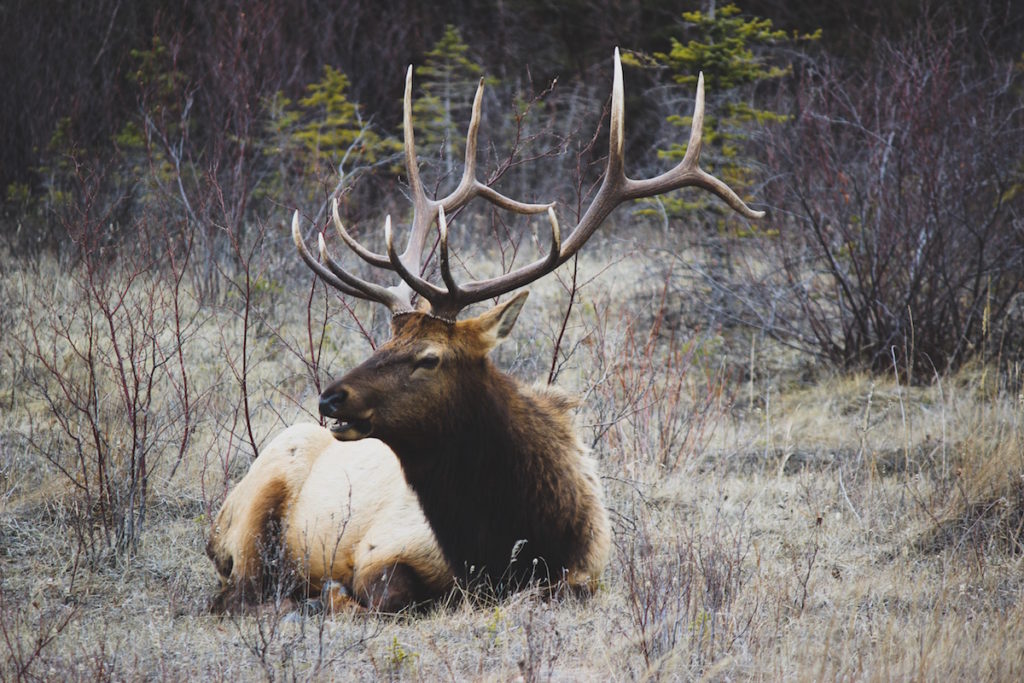
The Best States to Hunt Elk In
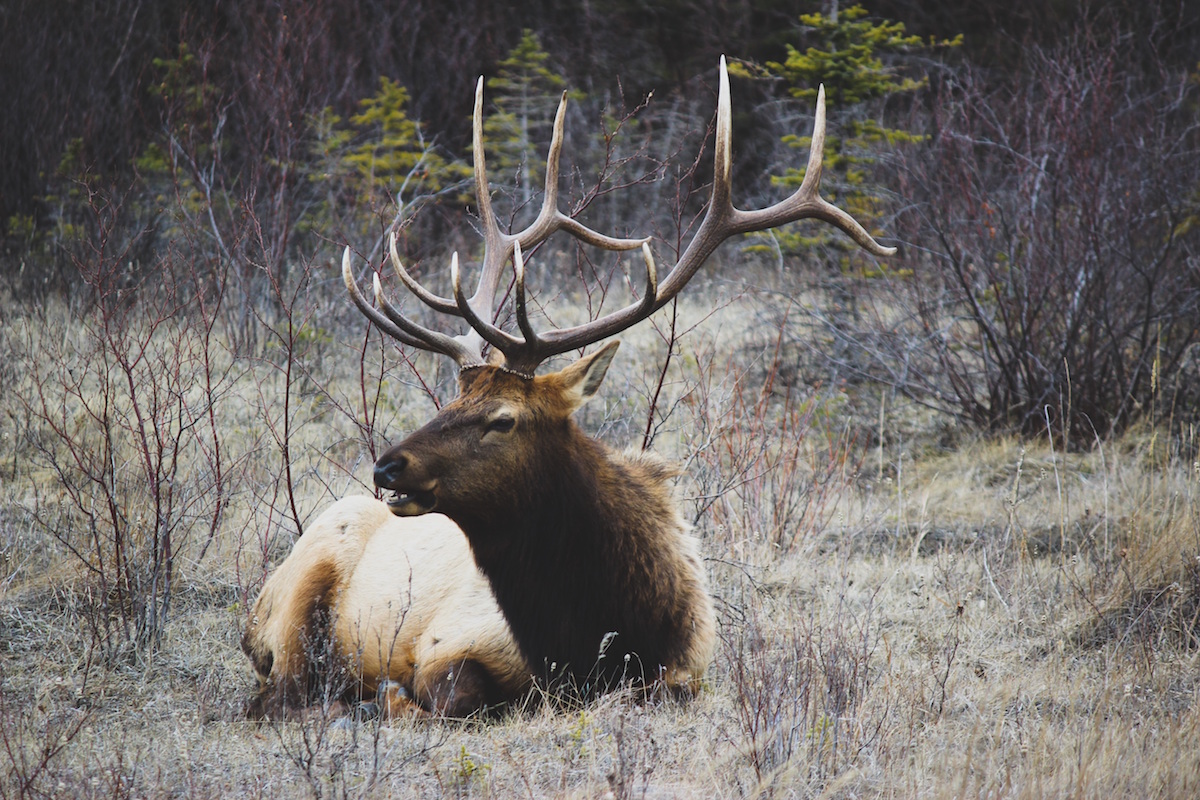 Elk are an iconic American game animal. Their enormous size, incredibly high quality meat, and beautiful antlers make them an appealing animal for all kinds of hunters to go after. Elk are located in many states in the US, and there is some incredible hunting to be done in a few select states. Enjoy!
Elk are an iconic American game animal. Their enormous size, incredibly high quality meat, and beautiful antlers make them an appealing animal for all kinds of hunters to go after. Elk are located in many states in the US, and there is some incredible hunting to be done in a few select states. Enjoy!
Colorado
You can do some elk hunting in White River National Forest. There are some healthy elk here. But the weather in this area is not friendly. It is very cold. Generally, Colorado has the largest population of elk and also has the most over the counter elk. It can boast of over 250,000 elk. Whether you prefer to hunt with a rifle or a bow and arrow, you have enough here. There are about 147 elk to hunt with arrow and 92 to hunt with a rifle. White River National Forest is a public hunting land. As a non-resident, it will cost you about $604 for hunting tag and license.
San Jauns in Southwestern Colorado is also a great place for elk hunting. It offers a lot of over the counter units. This is probably because San Jauns comprise of several high mountains. The northwestern region of Colorado is home to a large population of elk. The only problem with this site is that it is very difficult to hunt down a bull here.
Idaho
St Joe National Forest is a public domain for elk hunting. The major advantage of this forest is its proximity to another public elk hunting land – Clearwater National Forest. You might need a GPS to hunt in St Joe National Forest as it is much bigger than other forests. So, hunters have higher chances of getting lost here. Idaho is believed to have a total elk population of about 120,000. There are about 87 elk for over the counter hunting. You are free to use any of rifle, archery and muzzleloader as your hunting weapon. To hunt in this state it will cost you a total of $571.50 as a non-resident to hunt with either a rifle or a muzzleloader. But if you want to use a bow, it will cost $20 more.
Another great elk hunting zone in Idaho is the Snake River zone. This zone is so big that your choice of hunting location can either make your hunting a big success or a disappointing failure. It is quite advisable to move towards the northern part as it often produces better results than any other part of the zone. Units 63 and 63A produced fantastic elk hunting results last year. In fact, about sixty-five percent of the elk hunted in unit 63 were trophy quality. It is entirely a different story for hunters who chose southeastern part of the zone. Unit 68A produced the best result and it only produced five trophy quality elk.
Bannock Zone is an expansive elk hunting land but it produces little results. Last year, this zone yielded a discouraging success rate of just thirteen percent. Units 72, 74, 70, 73 and 73A produced encouraging results. The only heartwarming thing about hunting in this zone is that it has many trophy quality elk. As small as the numbers were, all the elk hunted in units 70 and 73A were all rated six-plus-points or more.
Bear River is about the smallest zone in Idaho. However, this should not discourage hunters as one out every five hunters who hunted there last year hit a target. This somehow proves that when it comes to hunting of elk, size of the land should not matter. The zone is at the other side of Bannock zone.
Tex Creek zone usually offers a high success rate but last year was an exception as it had an overall success rate of about fourteen percent. This could be ascribed to the fact that there was an upsurge in the number of hunters that hit this zone. In fact, a total of over 500 elk were hit last year. This zone comprises of both units 66 and 69. It is also worthy of mention that about forty-six percent of the elk killed in unit 69 were trophy quality while only twenty percent of the ones killed in unit 66 are trophy quality. In other words, your chances of hitting a record class elk are higher in unit 69.
Diamond creek zone comprises of some Rocky Mountains and Sweeping Valleys. It features a very rugged terrain for experienced hunters. Amateur hunters may find it difficult to cope here. It may pay off if you look beyond the rough terrain and head out there. This is because it yielded over twenty percent success rate last year. This is not even the best thing about Diamond Creek Zone. What will really interest elk hunters is that the bull spread out evenly between the two units that make up this zone. To cap it up, about forty-three percent of the elk shot were trophy quality. As mentioned earlier, the only challenge in this zone is the very rough terrain. This is why hunters who plan to come here have to be fully fit. In fact, he has to be certified fit by an appropriate authority.
Finally, Big Desert Zone is a very wonderful zone for hunting of elk. The only problem with this location is accessibility. Hunters have encountered a lot of difficulties accessing this zone. However, there is something that makes up for this shortcoming. It offers encouraging success rate. In fact, the zone had been yielding great figures in the past. The most wonderful thing is that about half of the elk harvested here turned out to record class elk. This is why hunters keep bombarding this zone despite the poor accessibility.
Montana
Montana is another great state for elk hunting. A very good public land for hunting in Montana is Beaverhead-Deerlodge National Forest. Montana can boast of about 160,000 elk. With a bow and arrow, hunters have between 15% to 40% success rate. Montana allows you use either a rifle or a bow for hunting. Non residents have to pay $826 to do some elk hunting in Montana.
Districts 123 and 124 are very good for elk hunting. They lie close to Clark Fork River and Thompson Falls. The major advantage here is that these districts of more shrubs and grass for elk consumption. You can also get a fair bull – cow ration of about 12 – 100. Its average success rate for the last five straight years is thirteen percent. The South and Middle Forks of the Flathead River also known as districts 150 and 151 are viable for elk hunting.
John Long Mountain and East of Rock Creek is a good one for hunters as it offers a success rate of about twenty two percent. On the average, about four hundred elk get killed here every year. And the most important part is that about half of them are bulls. Here, spikes are legal and this is why there is a high proportion of bulls taken.
Upper Rock Creek lies close of Long Mountain and it offers an impressive thirty percent success rate but with a lot of spikes. There are a few six-point-plus bulls here. The success rate is about thirty percent.
Wyoming
Wyoming is also another fantastic state for elk hunting. In fact, it has two national forests where elks can be hunted for days with a high success rate and both forests are public elk hunting lands. The forests are Bridger-Teton National Forest and Shoshone National Forest. Wyoming offers about 90,000 elk with an overall success rate of about 28 percent. You can hunt with either a bow or a rifle but at different elk hunting seasons. Bow elk hunting season is different from rifle elk hunting season. With a rifle, a non-resident can hunt in Wyoming for $577 and it costs $30 more for archery license.
In Wyoming, most of the elk are found on Rocky Mountains. But some others can also be found in the low mountain ranges. They are also scantily distributed in the Northwestern Great Plains.
Generally, there are several plenty of public elk hunting lands in Wyoming. In fact elk hunters are exposed to over 9 million of acres of US forest service land and about eighteen million acres of BLM land. That is a total of about 27 acres of elk hunting land. However, there is no correlation between size of land and the success rate of elk hunting. Not only that, you have to compare it with the number of elk hunters available. The size of land may not be impressive if divided by the over fifty-seven thousand hunters that are available.
As a non-resident, you are barred from hunting in certain wilderness areas without a guide. If you are not a resident, you can’t hunt trophy or big game animals on certain restricted wilderness area as stipulated by appropriate extant state or federal law except you are accompanied by a licensed guide. Some residents can act as your guide. Any of your friends or family member living in Wyoming can be your guide if he or she has a professional license. Residents can also apply for a license guide at no additional cost. However, they must sign affidavit that contains their name, address, license number of the nonresidents to be guided, the area to be hunted, game to be hunted and also state that no prize or compensation is expected. But there is a big clause to this. A single resident cannot guide more than two nonresident hunters in any year. This is to prevent residents from making a business out of it. They can begin to guide nonresidents for a token.
Oregon
Oregon is believed to harbor about 125,000 elk. It has two major species of elk. The Rocky Mountain elk and the other specie called Roosevelt. A very good elk hunting site in Oregon is Siuslaw National Forest. It is a public elk hunting land. This forest is relatively bigger than several elk hunting forests. So it requires a little more legwork than usual. Oregon residents experience more rain than many other states. Their elk hunting parks are no exception. As a non-resident, you can hunt with either a rifle or a bow after obtaining the license for about $641
Umpqua National Forest is another great elk hunting location and it is just a few meters away from Siuslaw Forest. It is an expansive area that comprises of over one million acres. It offers a relaxation spot (Crater Lake National Park) where you can stop to relax for some hours before moving on. The location houses several other animals like antelopes and deer that can also be hunted. You may try it out during the next hunting season as it does not host many hunters like other more popular elk hunting locations.
New Mexico
Cibola National Forest and Santa Fe National Forest are both veritable public lands for great elk hunting. However, New Mexico offers a very low percentage success rate for elk hunting. In other words, your chances of going back home with a game are very slim. In Cibola National Forest, the target areas should be Mount Taylor and Zuni Mountains. And in Santa Fe National Forest, Jemez area is the best.
Arizona
Coconino National Forest in Arizona also offers some elk for hunting but hunters barely go there because vehicles are highly prohibited in certain parts of the forest. Nobody likes restrictions so only a few hunters go there even though some of the biggest bulls in United States can be found in this national forest.
Washington
A very good public hunting land where there are several elks is Wenaha-Tucannon Wilderness. The number of elk here just increased recently after several years of discouraging figures caused by several forest fires and attacks from mountain lions. The famous Blue Mountain is one of the hot spots for hunting.
Utah
A tangible number of elk can be found in several locations within Utah. In fact the new world-record elk was hit last season in this very state despite having much less population of elk than other states. Hunters can find a sizeable number of undrawn tags in Uinta Mountains here in Utah.
In conclusion, it worthy of note that the figures mentioned above are tentative. They can always change at any time. Three major factors that can cause the changes are forest fires, regular attacks from predators and upsurge in the number of hunters.
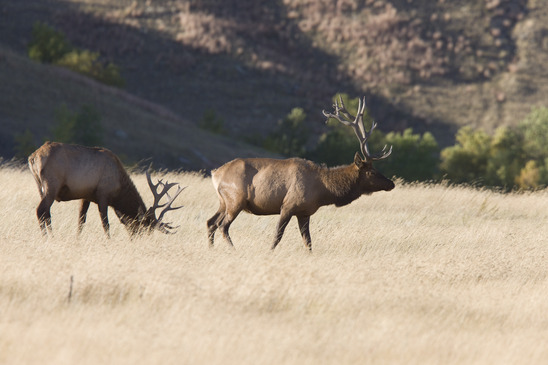
The Definitive Elk Hunting Equipment Checklist
 Elk hunting is very popular among hunters, and for good reason. Many hunters choose to go after elk because of the high quality of meat, and elk can be a fun and challenging game animal to hunt. For those who decide to elk hunt, it is important he or she follow state regulation, which will prevent fines or equipment loss if regulations are violated.
Elk hunting is very popular among hunters, and for good reason. Many hunters choose to go after elk because of the high quality of meat, and elk can be a fun and challenging game animal to hunt. For those who decide to elk hunt, it is important he or she follow state regulation, which will prevent fines or equipment loss if regulations are violated.
When an individual decides to go elk hunting, there are certain items that are needed to ensure a safe and successful hunt. Although the list is long, being prepared with the proper items is the best approach to successfully hunting elk. You don’t need to have everything on this list (some items are only useful for certain techniques of hunting, for example), but it is worth reading it over before a hunt to make sure you’ve got what you need.
General Equipment
A hunter will need to prepare general equipment before he or she embarks on an elk hunt. Here is a list of the general items a hunter should include on his or her hunt:
An Elk Hunting License: The first item a hunter needs to include on his or her checklist is a valid license to hunt elk. A license states that an individual has permission to hunt elk in certain areas. If an individual does not have a license to hunt elk, then he or she could face fines, jail time, or loss of equipment.
Ammunition: It is important to pack plenty of ammunition for the hunt. Elk are big game, so it is vital to choose ammunition that is suitable for hunting an animal of this size. The caliber should be an appropriate size to ensure a hunter can safely and humanely hunt the animal.
Rifle: If a hunter is not using a bow, then a rifle should be part of the list. A hunter should choose a rifle that is appropriate for elk hunting. A male elk can weight 600 to 800 pounds, so a hunter should choose a rifle that is suited for killing an animal that size. A rifle with a big caliber that can penetrate the elk at a variety of ranges is the best choice.
Gun Case: A rifle/gun case is needed for elk hunting. A gun case safely stores a rifle when a hunter is not actively pursuing an animal. A hunter needs a gun case to protect his hunting equipment, and a gun case also adds safety for a hunter and those around him or her.
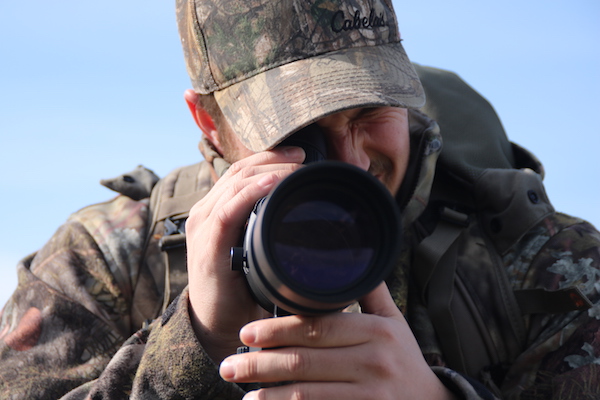 A Spotting Scope: A spotting scope is an important item for elk hunting. A spotting scope has higher magnification than binoculars. It offers hunters a precise image from long-range distances, a spotting scope can be more expensive than a set of binoculars. When elk hunting, a spotting scope is worth the investment.
A Spotting Scope: A spotting scope is an important item for elk hunting. A spotting scope has higher magnification than binoculars. It offers hunters a precise image from long-range distances, a spotting scope can be more expensive than a set of binoculars. When elk hunting, a spotting scope is worth the investment.
Binoculars: For those who do not want to invest in a spotting scope, then a good set of binoculars can be an effective way to spot elk. A hunter should be sure to purchase a set of binoculars with high-quality glass, which will prevent a hunter from straining his or her eyes.
Scent Reduction Spray: Elk have an acute sense of smell, which is why a scent reduction spray should be included on the list. A scent reduction spray eliminates odors on a hunter’s clothing. A hunter will need a scent reduction spray to eliminate the odors that elk can identify as foreign.
Scent Attractant: A bull elk will be attracted to the scent of a female in heat. A scent attractant can work by mimicking the scent of a female elk in heat and attract males. A hunter can benefit from using scent attractant because it will obviously lure male elk to the area.
Water Purifying Tablets: When hunting, it is best to be prepared for any circumstances that may arise. In the event a hunter becomes lost, water purifying tablets can help a hunter stay hydrated until help arrives.
Range Finder: A range finder is a helpful instrument that should be taken on an elk hunt. A range finder accurately estimates the distance of an object. When a hunter has a range finder, then he or she will be able to determine the distance between him or her and the elk.
Sunscreen: When a hunter is in pursuit of an animal, he or she may have to spend hours in the sun. In order to prevent sunburn, a hunter should pack sunscreen. A hunter should even apply sunscreen on cloudy days for added caution against sunburn.
Bipod: A bipod should also be on a elk hunting checklist. A bipod is a two-legged stand that holds an instrument steady. A bipod is important for an elk hunting trip because it can hold a rifle steady and reduce motion.
A Game Camera: A game camera is ideal to have on an elk hunt. A game camera can track elk and where they move. If a hunter has a game camera and uses it to spot elk before the season starts, then it can raise the chances of a successful hunt.
A Gun Hoist: A gun hoist enables a hunter to quickly hoist his or her rifle up to a hunting stand. A hunter can benefit from a gun hoist because it allows him or her to safely get a rifle up to the hunting stand, which will help prevent any injuries or damage to the rifle.
Thermacell: In some states, such as Arizona, an individual can hunt elk starting in mid-August during bow hunting season. If a hunter is planning a hunting excursion during warm months, then he or she should pack a thermacell. A thermacell is a device that repels mosquitoes without a scent. Mosquitoes can be a menace when hunting, so having a thermacell handy can prevent potential mosquito bites.
A Compass or GPS: A compass or GPS should be included in a hunter’s equipment. There are some GPS systems now that can mark and save a location after a hunter has been scouting, which makes it easy for him or her to easily reach their destination on the day of the hunt. A compass or GPS system can also help prevent a hunter from getting lost in unfamiliar territory.
A First-Aid Kit: A first-aid kit is variety of supplies, which can include band-aids, gauze, and antibiotic ointment. A hunter can purchase a first-aid kit or make one. A first-aid kit is a necessary item when hunting because the hunter is using potentially dangerous items that could cause them bodily harm. A first-air kit can help to stop bleeding or clean wounds that could be fatal or severe if left untreated.
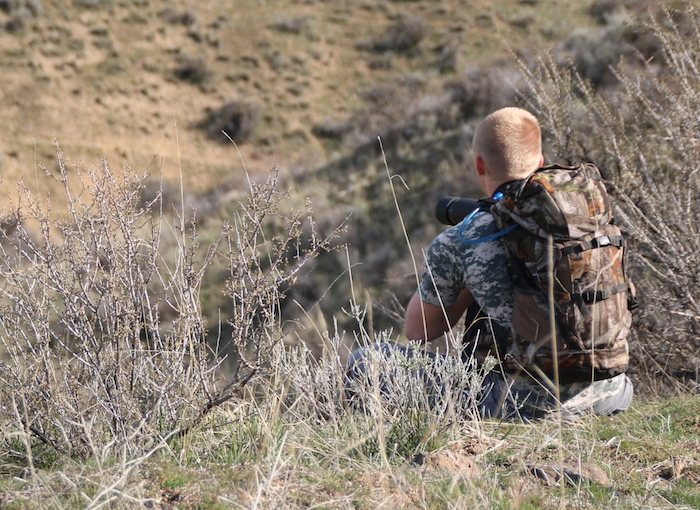 Backpack: Most elk hunters end up carrying quite a bit of a gear into the field, not to mention a huge amount of meat on the way out if a hunt is successful. To carry it all comfortably, it is worth investing in a quality backpack designed to hold everything you plan on carrying as well as pack out the animal. Check out our guide to hunting backpacks to learn more.
Backpack: Most elk hunters end up carrying quite a bit of a gear into the field, not to mention a huge amount of meat on the way out if a hunt is successful. To carry it all comfortably, it is worth investing in a quality backpack designed to hold everything you plan on carrying as well as pack out the animal. Check out our guide to hunting backpacks to learn more.
Ax/Handsaw: An ax or handsaw is vital when hunting because it might assist in helping a hunter achieve a clearer view of the area they are watching, and it allows them to have a clean shot on their prey. If there are branches in the way of a hunters prey, then it may mean that they are unable to take a shot at that trophy elk. With the trimming of a few small branches, a hunter can clear his line of sight while still leaving himself covered.
Food and Beverages: When an individual is hunting, it is crucial to take plenty of high-energy snacks and beverages such as water or Gatorade. Hunting is extremely physical and elk are large animals that will use an ample amount of energy to move and clean if one is killed. By having plenty of snacks and beverages available, a hunter can keep his or her energy level elevated.
Hand Warmers: When it is cold outside, hand warmers can be beneficial to hunters. Hand warmers keep a hunter’s hands warm for a brief period of time, which can help a hunter stay comfortable in cold weather.
An Elk Decoy: An elk decoy is a handy item to have when hunting, which will help a hunter attract elk. An elk decoy can make a bull elk feel less threatened and approach the area, and it gives the hunter the opportunity to design his or her shot carefully.
A Flashlight: A flashlight can help a hunter find his or her path in the early morning or late evening when there is not an abundance of light. When a hunter packs a flashlight, he or she should be sure the flashlight is equipped with batteries and should pack extra batteries as well.
Toilet Paper: Toilet paper is essential when going on a hunt. If you have ever been stuck on a hunt without toilet paper, then it can make for an uncomfortable and messy situation.
Trail Marking Tape: A hunter uses trail marking tape to mark his or her path back-and-forth to a tree stand. Trail marking tape is useful because it also alerts other hunters of your position, which increases safety.
Flares: It is always a good idea to be prepared for any circumstances that may arise when elk hunting, which is why flares should be included on a hunter’s list. If a hunter becomes lost, then a flare can alert a game warden or forest ranger of his or her position.
A Two-Way Radio: Two-way radios are perfect for a hunter who needs to stay in touch with his or her group. A hunter should be sure to select a two-way radio with good range that can work effectively in heavily wooded areas.
A Sleeping Bag: A sleeping bag can be useful when a hunter gets cold or wants to take a nap. The sleeping bag should be waterproof and insulated to help a hunter stay comfortable in rain or cold weather.
A Waterproof Bag: A waterproof bag can come in handy if it rains on a hunting trip. A waterproof bag will keep food, extra clothing, and other equipment dry while it is raining.
A Wind Indicator: A hunter should check the direction and strength of the wind regularly. The direction and force of the wind can have an impact on how a hunter shoots. A wind indicator can gauge the direction and speed of the wind, which will help increases the chances of a successful shot.
Archery Equipment
If an individual plans of hunting elk with a bow and arrow, then he or she will need to take these items on the hunt:
Arrows: If an individual is hunting elk with a bow and arrow, then an ample amount of high-quality arrows need to be packed for the hunt. A hunter needs to be sure to select the right arrows considering the size of the animal.
Bow: A bow is essential when a hunter is planning to hunt elk by archery. A bow should be suitable for hunting large animals such as elk. If a hunter is hunting elk by archery, then it could be beneficial to take an additional bow.
Arm Guard: An arm guard is especially handy for those who want to hunt elk with a bow and arrow, and arm guards are usually made of leather or plastic. Arm guards protect the inside of a hunter’s arm from injury while the hunter is shooting.
A Bow Case: If a hunter plans on using a bow an arrow for hunting, then he or she will need a sturdy bow case. When a bow is not in use, it should be kept in a bow case to protect the bow from being damaged.
A Quiver: A quiver is a container that is used to hold arrows. A hunter will need a quiver when hunting with a bow and arrow. Based on preference, a hunter can use a quiver that is carried on his or her shoulder or placed on the ground.
Broadhead Sharpener: A broadhead sharpener keeps the multiple blades of an arrowhead sharp. A hunter needs a broadhead sharpener to keep the blades razor-sharp, which helps ensure the arrow effectively penetrates and kills his or her target.
Wrist Sling: When a hunter is using a bow and arrow to hunt, a wrist sling should be part of his or her checklist. A wrist sling attaches to the handle of the bow. It is a braided rope that wraps around a hunter’s wrist, which will his or her grip loose. A wrist sling increases accuracy and minimizes error.
Sound Dampeners: A hunter should take sound dampeners when bow hunting elk. They are used to reduce the noise the arrow makes when it leaves the bow. If the string or the arrow slaps the bow as it projects toward the target, the elk may hear the noise and move out of the way of the arrow.
Kisser Button: A kisser button is a device used to pull the string of the bow back, which will help increase accuracy because it acts as a trigger.
Clothing
It is very important a hunter prepares for an elk hunt by packing proper clothing, which can protect the hunter against harsh weather. When preparing for an elk hunt, be sure to pack the following articles of clothing:
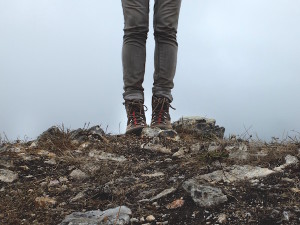 Boots: Proper footwear is important when embarking on an elk hunt. Insulated and waterproof boots can keep a hunter’s feet dry and warm. Insulated boots can also protect a hunter’s feet from becoming injured from dangerously cold weather.
Boots: Proper footwear is important when embarking on an elk hunt. Insulated and waterproof boots can keep a hunter’s feet dry and warm. Insulated boots can also protect a hunter’s feet from becoming injured from dangerously cold weather.
Insulated Socks: Insulated socks should also be included when packing for an elk hunt. Depending on the weather, insulated socks can help keep a hunter’s feet warm and protected against harsh weather.
Gloves: When it is cold outside, gloves are necessary for elk hunting. Gloves can protect a hunter’s hands, and they keep a hunter’s hands comfortable in extremely cold weather.
A Face Mask: A face mask can be a useful clothing item for an individual hunting elk. A face mask can protect against wind and cold weather, and it can protect against the sun.
A toboggan or baseball cap: When it is cold, a hunter should take a toboggan to keep his or her head warm. If it is warm, then a baseball cap can help keep the sun out of a hunter’s eyes. It is recommended that hunters wear hats that are bright orange or yellow, which will help them stay visible to other hunters.
Safety Vest: In order to practice safety when hunting, hunters should always take necessary steps to make themselves visible to other individuals who may be hunting in the same proximity. A bright orange or yellow colored vest should be worn by a hunter at all times, which can help prevent accidental shootings.
Insulated/Moisture Wick Clothing: A hunter should be prepared to stay warm when he or she is hunting in cold or wet weather. Insulated and moisture wick clothing will keep a hunter dry and warm throughout a hunt. Long and short sleeve shirts, pants, windbreaker jackets, and underwear should be included on the list.
A Rain Suit: A rain suit is also an essential clothing item that should be included on an elk hunt. A rain suit allows a hunter to continue to pursue elk without becoming too wet when it is raining. When it is raining, staying dry with a rain suit will help a hunter stay comfortable.
After the Kill Equipment
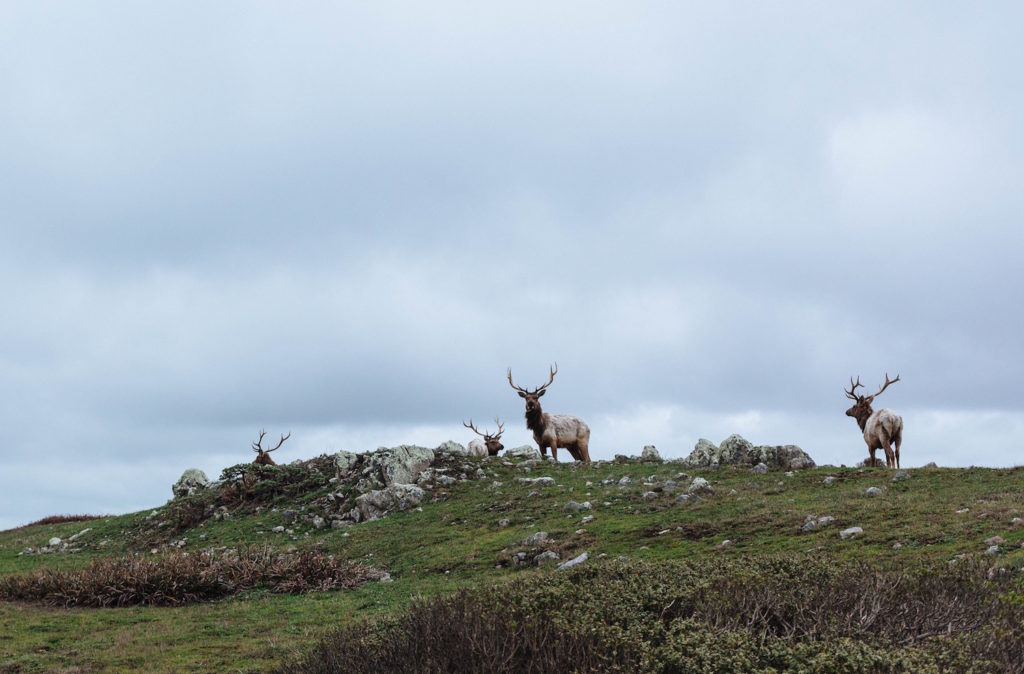 If a hunter is fortunate enough to kill an elk, then there are certain items that are needed after a kill. To be prepared to the fullest, a hunter should be sure to pack these items that are necessary after the kill:
If a hunter is fortunate enough to kill an elk, then there are certain items that are needed after a kill. To be prepared to the fullest, a hunter should be sure to pack these items that are necessary after the kill:
Game Cart: A game cart is a cart or buggy that is used to haul the elk to the destination where it will be cleaned. Elk are extremely large animals and it would be almost impossible for a hunter to move on his or her own. A game cart makes transporting the elk faster and easier.
Game Shears: Game shears are used to cut the limbs off the elk during cleaning. Game shears are designed to efficiently remove limbs from large animals, and game shears are quicker and easier than using bone saw.
Game Bags: Game bags are used to store meat. When a hunter packs durable game bags, the meat collected after the kill will stay free from debris, insects, and dirt. Elk meat is known for its quality, which is why it is important to preserve the meat by using game bags that will protect it from the elements.
A Pelvic Saw: A pelvic saw can be used to cut through the pelvic bone and any other areas that are too strong for game shears. Cutting through an elk’s pelvis or sternum can be extremely difficult, which is why a strong pelvic saw can be extremely useful when cleaning an elk.
Knives and a Sharpener: A hunter should be sure to pack knives and a sharpener, which are needed for cleaning after the kill. Knives are used for skinning during the cleaning process, so they should be sharp. A sharpener should also be packed in case any of the knives become dull during cleaning. For field dressing an elk, you’re probably going to want to invest in a top quality fixed blade knife.
A Cooler: If a hunter is planning on taking the meat home, then a cooler is essential to preserve the freshness and quality of the meat.
When preparing for an elk hunting trip, it is important to pack all the items necessary to ensure a hunter stays safe and has a good chance to kill his or her prey. Elk are extremely hard to hunt. When a hunter is prepared with the right equipment it allows him or her to focus on hunting elk, not stressing about forgotten items that should have been packed.
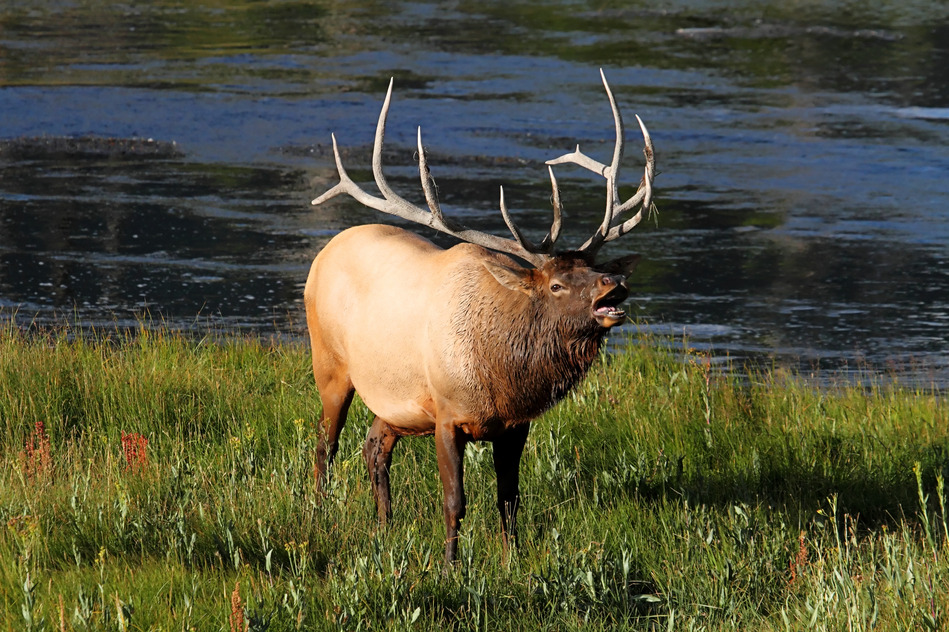
20 Elk Hunting Tips For a Successful Hunt
Elk hunting is a very exciting sport that many people can enjoy by visiting the Midwest or northwest of the United States or Canada. Elk, also sometimes affectionately referred to as Wapiti, are the largest deer in the world. They are sometimes referred to as Wapiti because that is the term given to them by the Shawnee people and the Cree nation. The term “Wapiti” is used to maintain the history of the Native Americans who were here before any European settlers. The danger and physical strain of the sport make it especially challenging for any hunter, which just adds to the appeal.
 This article will list twenty tips for hunting Wapiti, from preparation to the kill. This adventure can be the time of your life if you take the time to prepare and be safe; however, if you decide not to follow these tips, your chances of success go down, and you could even end up having a serious problem like an injury in the field. This is because of the freezing temperatures, the wildness of the location, and the unpredictability of wildlife, from the elk you are hunting to the mountain lion who might be hunting as well.
This article will list twenty tips for hunting Wapiti, from preparation to the kill. This adventure can be the time of your life if you take the time to prepare and be safe; however, if you decide not to follow these tips, your chances of success go down, and you could even end up having a serious problem like an injury in the field. This is because of the freezing temperatures, the wildness of the location, and the unpredictability of wildlife, from the elk you are hunting to the mountain lion who might be hunting as well.
1. Know your prey.
Study as much as you can about Cervus Canadensis (also known as Wapiti). Being a hunter, especially of elk, is like being in the military: the more information you know about the situation, the better capable of following out orders you will be. Learn the elk’s diet, hoof prints, and what their senses are like to get a good idea of what you should do when hunting elk. Also get to know their gestation period, average weight and size, and the differences between a bull and cow elk. The best way to learn all this information is to buy a hunting guide to elk, such as All About Elk by Mike Lapinski. A book of this standard will teach you everything you could possibly need to know about the prey you are hunting. There are many different books about the elk and how to recognize their habitat and locations, but the book listed above will be a good jumping off point. The point is to read and read a lot; you cannot hunt an animal well if you do not know about it.
2. Follow the hunting regulations.
The main hunting regulation that you must follow is that every hunter must have a hunter’s license issued to them for the state they are hunting in, regardless of residency. You will also be required to provide proof that you took a hunting safety course and, in some states, a gun safety course. You may also need to get special tags or permit required for the state, which are usually given out by lottery. Make sure you check how many kills your permit or tag allot to you for the season to avoid fines, confiscation of weapon and animal, and/or jail time. Without the hunting license and proof of courses passes, along with any special permits or tags, you will be considered a poacher and be fined around $1500 or go to jail.
3. Choose the proper rifle for your needs.
Do not buy a rifle simply because a friend or review recommends it. You will need to pick a firearm that suits you best. There are many options for hunting rifles, with the best rifles only available at gun stores. The features you should look for most in a rifle are manufacturer’s reputation, caliber, stock, and scope optics. First, look for a weapon by a manufacturer with a good reputation. This is where you can ask opinion of your friends and fellow hunters. Some manufacturers with especially good reputations are Winchester, Remington, and Walther. Second, do your research to find the right caliber for you. Every caliber size has its pros and cons. The most popular calibers, however, are .270 Winchester, .308 Winchester, .30-06 Springfield, and .300 Winchester Magnum.
The next thing to consider is whether you want a bolt-action or semi-automatic rifle. You may want the safe, dependable, and accurate bolt-action rifle or you may want the chance to fire off extra rounds with a semi-automatic rifle. Finally, you will want to look at the optics of the scope, as that is how you will spot your target shots. Some hunters go a little crazy when it comes to magnification, but you will be better off with quality over magnification. Look for a scope that has good quality and is ideally either 2-7x or 2.5-8x for elk hunting. Make sure the rifle is less than nine pounds, as you will need to carry it long-distance to get to the hunting location. You may also want to get a carrying case with a shoulder strap or a sling that will mount on the rifle’s stock. With one of these two options, the weight of the rifle will be on your shoulder and back instead of your arm and hand during your trek from camp to the location where you will hunt. Thus, you will be able to hold your firearm longer when you get positioned for the shot because your arm and hand are not tired from carrying it.
If you want a good starting point on buying a rifle, check out our guide to hunting rifles, which has a section specifically for elk hunting.
4. Learn proper shot placement.
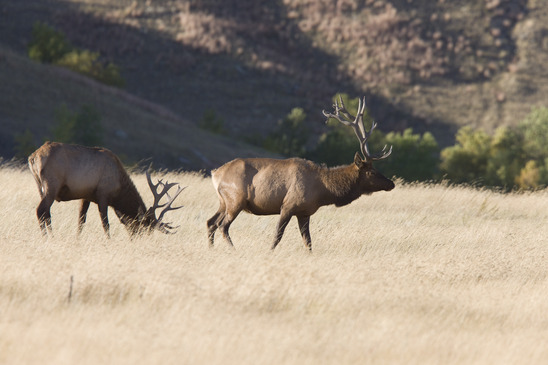 It is your responsibility as a hunter to make a clean kill and be able to recover the elk after the shot. It is important to find an elk anatomy guide and study it thoroughly. The shot placement that all hunters should aim for is the center of the lungs or slightly lower than that center. A shot placed to penetrate both lungs will bring an elk down quickly and relatively painlessly. As you can see if you have an anatomy guide, the elk’s heart is placed slightly lower than the center of the lungs, so even if your shot is a little lower than intended, it still might penetrate the heart, taking down the elk swiftly and cleanly. It is highly suggested that you practice on an elk target before going to hunt, whether you are a novice or experienced hunter. Visit an active target range where they have multiple styles of elk targets, as well as moving targets, to maximize your experience and accuracy before making the shot that counts. Also, if you are using a bolt-action rifle, you may want to practice fast reloading to get multiple shots in within a short time frame. Finally, do not practice just at one distance; multiple distances are preferred because in the field you will not know how far your target will be.
It is your responsibility as a hunter to make a clean kill and be able to recover the elk after the shot. It is important to find an elk anatomy guide and study it thoroughly. The shot placement that all hunters should aim for is the center of the lungs or slightly lower than that center. A shot placed to penetrate both lungs will bring an elk down quickly and relatively painlessly. As you can see if you have an anatomy guide, the elk’s heart is placed slightly lower than the center of the lungs, so even if your shot is a little lower than intended, it still might penetrate the heart, taking down the elk swiftly and cleanly. It is highly suggested that you practice on an elk target before going to hunt, whether you are a novice or experienced hunter. Visit an active target range where they have multiple styles of elk targets, as well as moving targets, to maximize your experience and accuracy before making the shot that counts. Also, if you are using a bolt-action rifle, you may want to practice fast reloading to get multiple shots in within a short time frame. Finally, do not practice just at one distance; multiple distances are preferred because in the field you will not know how far your target will be.
5. Cover your scent.
It is extremely important that, when hunting elk, you cover your scent. This is because elk, like many deer, can scent a human very easily and will scare away. Starting several days before you go on the hunt, bathe with unscented soap, wash your hair thoroughly with unscented shampoo, and wear unscented deodorant. You will also want to use unscented laundry detergent on your elk hunting outfit. Finally, you should use a commercial scent coverer or scent eliminator. These products can all be found at your local hunting gear retailer.
6. Use the right elk call for maximum effect.
Using an elk call can really drive in the elk for the kill. Not everyone can use one, but if you can, you will want to find the right one for the season you are hunting in. There are six types of elk calls, two for bull elks and four for cow elks. For the bull elk, the two types are the bugle call, which is used during pre- and post-rut, and the wake call, which is used during pre-rut. For cow elks, there are four types: the cow elk call is used during pre-rut to call both cows and bulls; the excite call is used during the peak of rut when cows are looking to mate; the muse and soft chirp call is used to coax a bull that is close to your position; finally, the alarm barks call is used to try and stop a scared elk long enough to take the shot. There are two tips that cannot be stressed enough. First, practice as much as possible. If the state you want to hunt in allows elk calling without a permit or tag, practice calling the bulls and cows even if you do not win the lottery for a permit or tag. Just call over and over and see what happens each time. Secondly, always be ready to take the shot before you call a bull or cow. There are many other ways to use elk calls, such as imitating a herd and bugling as you run away, but you will want to start with the basics. Be patient, as learning to call elk is not an overnight process. If you are unable to learn the elk calls on your own, ask an experienced elk hunter to help you with your calls. Experienced hunters will usually be more than willing to help out the novice because they were once there too. Remember if one technique does not work for you, there are several other techniques to try.
7. Scout the area you want to hunt in.
Even if you have been to the location you want to hunt in, you should scout the area to learn what nature has done to change it. If you are brand new to the area, take out some topographical maps and study the layout of the land. Then, go there and find a few places you think will be good for hunting the elk, taking into mind elk trails and tracks, potential food nearby, the proximity to a local herd, dens of predators, and where you would wait. Keep an eye out for natural obstacles such as rivers and cliffs that will keep you from reaching your destination quickly. In choosing a hunting location, be wary of watering holes and food supplies, since elk are not the only ones who will be using them. Find your hunting location at least a week before you are prepared to hunt, and assemble your stand or blind. Then pack it with your provisions so the elk can get used to the newness and will return by the time you come back to hunt. Get to know the land and you will not have to scout it out the day of the hunt.
8. Get to your hunting location before the elk do.
Elk move the most during the first few hours after dawn and dusk, so you will likely need to get to your location by flashlight. If you get there too late, you will scare off any elk that are already there. Keep in mind that elk have excellent sight and hearing and will run off easily if startled. The sooner you get there, the more used to the new sights and sounds the elk will be and the more likely they are to come when called.
9. Novice hunters should make use of an elk hunting outfitter.
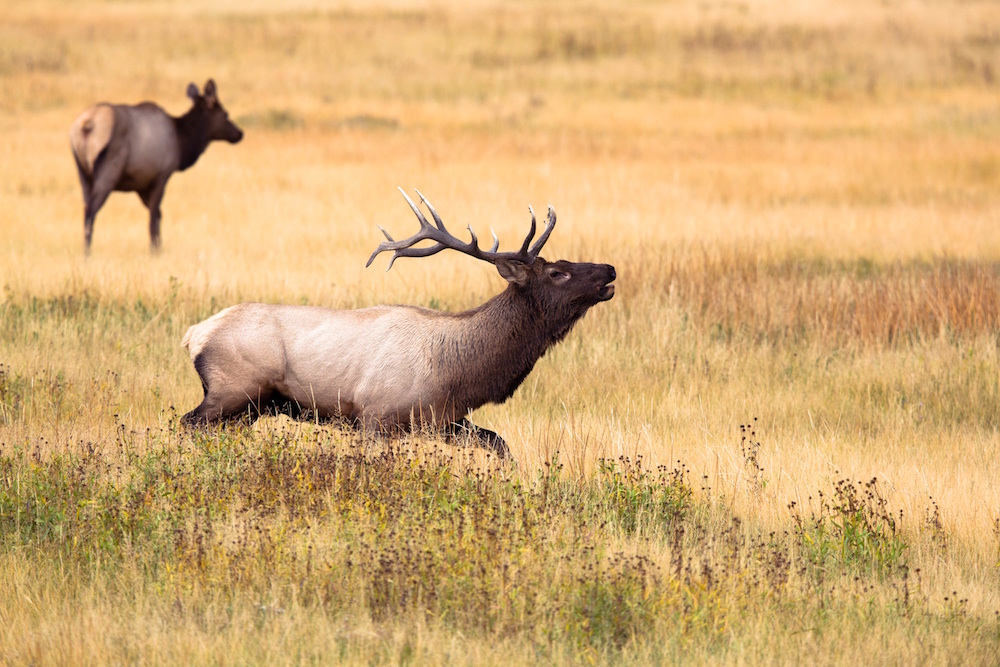 You will want to make use of an elk hunting outfitter if you have never hunted this large deer before. Elk hunting outfitters are very experienced hunters who guide novice hunters on their trip. They provide transportation, gear (called outfitting), food, horses, and shelter. They also use their expertise to ensure the hunters they guide are having fun and bag the elk they are there to hunt. As a novice hunter, be sure to ask for references and ask plenty of questions! Questions might include asking what provisions you should bring, how much experience the outfitter has, and how well they know the area where you are going. You should also find out the outfitter’s plans for emergency situations.
You will want to make use of an elk hunting outfitter if you have never hunted this large deer before. Elk hunting outfitters are very experienced hunters who guide novice hunters on their trip. They provide transportation, gear (called outfitting), food, horses, and shelter. They also use their expertise to ensure the hunters they guide are having fun and bag the elk they are there to hunt. As a novice hunter, be sure to ask for references and ask plenty of questions! Questions might include asking what provisions you should bring, how much experience the outfitter has, and how well they know the area where you are going. You should also find out the outfitter’s plans for emergency situations.
10. Ensure you have personal protective equipment (PPE).
There are two types of PPE you will need for hunting. The first is safety glasses. You want safety glasses to protect your eyes from UV light, gun powder residue that the wind might blow back in your face, and the chance that a stray shell will come back and hit you in the eye. The other type of PPE you need is ear plugs. You want ear plugs rather than muffs because you will want muffs that keep you warm. Hunters often overlook wearing ear plugs, but it can be one of the most important things you wear because without ear plugs, you are likely to lose one of your important hunting scents, your hearing.
11. Know the difference between a person and an elk.
The elk, five foot tall at the shoulder, compares in height to a horse. When hunting, especially in poor weather conditions, the differences between a horse and a cow elk are hard to recognize. Always wait until the entire elk or horse is in view and look for the hunter’s orange vest, belt, or cap on the back of the animal. The rider may be riding low to keep warm against the horse’s body, so make sure you look for that hunter’s orange clothing before you make a shot. Hundreds of injuries every year to humans and horses occur because hunters do not take the time for the whole mammal to come into sight and/or do not look for the hunter’s orange clothing. Also, if you see movement, wait until you have a confirmed clear target. Often, hunters mistake any movement for the movement of their prey. By confirming the target, it is unlikely you will shoot a person instead of the trophy of a lifetime, so stay safe by always checking twice before making a shot.
12. Learn how to field dress your kill.
There are several methods of field dressing an elk. The three most common methods are capping the elk for shoulder mounting, the basic field dressing, and the gutless boning method. Cape the elk for shoulder mounting if you want to save the hide and head for taxidermy. If you are not interested in keeping the horns or hide, you can use the basic field dressing, which is good for if you are close to camp, especially if you want to keep the bones. The gutless boning method is a great way to preserve the meat, but it does only that. This method is good if you are back country hunting, as there is no reason to take all those heavy bones with you. Whatever method you choose, you will want to have a sharp hunting knife and some garbage bags for storing the meat to cool it down and carry it. You may also want to carry a knife sharpener because dressing an elk is long work that dulls a blade quickly, making it necessary to sharpen the hunting knife during the process. While dressing, no matter what method you use, be very careful to not puncture the stomach; if you do, you will hear a whooshing sound, which means you need to work extremely fast to keep the stomach’s contents from tainting the meat. Remember, if you shoot the animal, it is your responsibility to dress the animal and not let the meat go to waste.
13. Clean and store your weapons of choice with care.
Every time you make a shot, carbon and copper is deposited in the barrel of your firearm. After twenty rounds, the fouling will get so bad that it will affect the accuracy of the rifle. Use a good, strong copper solvent in the bore to ensure a clean rifle for true accuracy. You will also want to clean your hunting knife after every field dressing. Hunting knifes are vulnerable to rusting, whether carbon steel or stainless steel. In the field, you should clean the knife by wiping it carefully with a rag, making sure to get all cracks and crevices, particularly where the handle meets the blade. However, this cannot take the place of a thorough cleaning when you get home. Use rotor oil and rub it in with a rag to get the knife properly cleaned and ready for the next dressing. Store your rifle and your knife in the proper cases to prevent damage from moisture, dust, dirt, or other foreign materials. By cleaning and storing your weapons properly, you will get more years out of them than if you left them uncleaned and in the open. You will also prevent unnecessary service by a gunsmith, saving you hundreds of dollars.
14. Watch videos and read articles to learn good techniques.
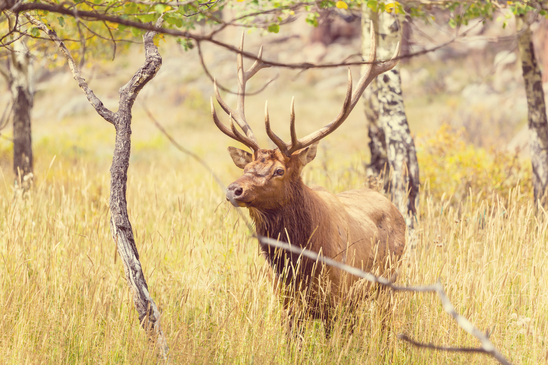 There are many websites that provide articles and videos on techniques for hunting, but elk hunting is a bit different from hunting deer or rabbits. There are not nearly as many websites about hunting elk as there are about hunting small game and deer. One website that has articles and videos about everything related to elk hunting is Elk101.com, which is dedicated to the sportsman. Their articles and videos will teach you all that you need to know beyond this article, from how to get an elk tag to how to get into “elk shape.” YouTube also has a wide variety of videos on elk hunting techniques and general hunting techniques from channels like the National Shooting Sports Foundation and ElkNut Outdoor Productions. You can also watch a variety of videos and read many articles to develop your own technique from bits and pieces of others’, creating the perfect style of hunting for you.
There are many websites that provide articles and videos on techniques for hunting, but elk hunting is a bit different from hunting deer or rabbits. There are not nearly as many websites about hunting elk as there are about hunting small game and deer. One website that has articles and videos about everything related to elk hunting is Elk101.com, which is dedicated to the sportsman. Their articles and videos will teach you all that you need to know beyond this article, from how to get an elk tag to how to get into “elk shape.” YouTube also has a wide variety of videos on elk hunting techniques and general hunting techniques from channels like the National Shooting Sports Foundation and ElkNut Outdoor Productions. You can also watch a variety of videos and read many articles to develop your own technique from bits and pieces of others’, creating the perfect style of hunting for you.
15. Decide whether you want a tree stand or ground blind and learn how to assemble it.
Hunters are constantly debating the merits of a tree stand and ground blind against each other. The truth is, they both have advantages and disadvantages that you will want to consider carefully before deciding which to use. If you go high enough (about thirty feet), your scent will not be detectable by elk, but your playing field will be lessened, while a tree stand at fifteen to twenty feet will give you a great advantage for targeting elk on the ground, but no elk will come near your tree stand because of scent. Finally, a ground blind requires that everything you use and wear has to be washed in scent-eliminating detergent, but will greatly reduce your playing field and is more tedious to set up. Whatever you decide to use, know how to assemble it before you get into the wilderness and work with your team of hunters and/or guides to assemble it quickly. Keep in mind, also, that while the stand or blind hides you, the movements and sounds you make are noticeable from a lot further of a distance than you might think.
16. Shop for clothing appropriate to the season and climate where you will be hunting.
When you are hunting elk, it is going to be freezing cold because you are likely to be in the mountains where the elk are more plentiful. Your clothing needs to reflect this. Make sure you have a base layer of long underwear (shirt and pants). Cover this with a long-sleeved shirt and long camouflage pants and one or two layers of socks, at least one of these being wool. You will also want warmth-giving accessories, such as hunting gloves (with or without a trigger finger), a lightweight coat or quilted shirt jacket, a medium-weight camoflauge exterior jacket, headgear such as a toboggan or skull cap, and earmuffs. Also, wear a scarf or similar piece of clothing to keep your neck and face warm. Of critical importance are your boots. An ill fitting pair of boots can make elk hunting miserable and almost impossible. Read our guide to hunting boots to get an idea of what you need. Finally, keep hand and foot warmers close at hand to insert into your gloves or boots in case your extremities become too cold. With the proper attire, you will be able to maintain body temperature and keep up your strength throughout the day.
17. Prepare for all weather.
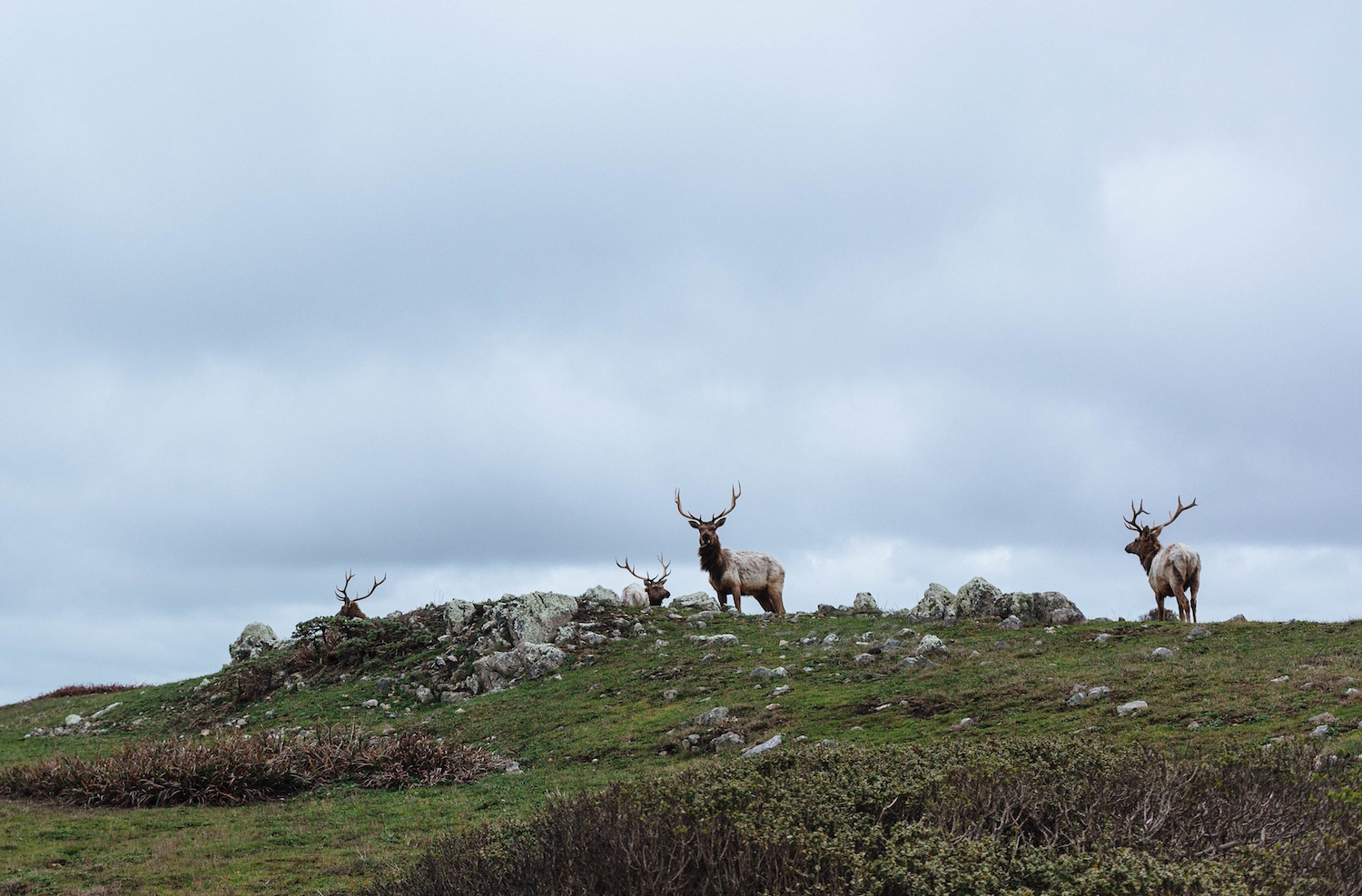 The weather can change at a minute’s notice, and you need to be able to change with it while hunting. Part of your pack should be dedicated to sunscreen, rain gear (such as a poncho or rain suit), and a first-aid kit for slips and falls due to mud, ice, or snow. In addition, you will want to either water-proof your boots or pack rubber golashes. You can also get slip-on rubberwear to cover your boots that weigh less and do not take as much room in your pack as goulashes. If you get soaked by precipitation, immediately return to camp and change into dry clothes to prevent hypothermia and frostbite. The elk will still be out there when you return to hunting, but you will not be able to continue hunting if you get hypothermia and/or frostbite.
The weather can change at a minute’s notice, and you need to be able to change with it while hunting. Part of your pack should be dedicated to sunscreen, rain gear (such as a poncho or rain suit), and a first-aid kit for slips and falls due to mud, ice, or snow. In addition, you will want to either water-proof your boots or pack rubber golashes. You can also get slip-on rubberwear to cover your boots that weigh less and do not take as much room in your pack as goulashes. If you get soaked by precipitation, immediately return to camp and change into dry clothes to prevent hypothermia and frostbite. The elk will still be out there when you return to hunting, but you will not be able to continue hunting if you get hypothermia and/or frostbite.
18. Stock up on the right foods and beverages.
Elk hunting is very demanding on the body, so eat nutritious food rather than junk and processed foods. Balance your meals between proteins and carbohydrates, with a good mix of fruits and vegetables thrown in as well. Do not diet while hunting elk; you need a moderate amount of fat to keep your body going. Free-dried foods are a great way to get a balanced diet without the weight of cans or bottles. By adding water and heat, you can have a healthy meal in minutes. Sodas and fruit juices are no good; stick to your water and lots of it. Also, keep on hand small snacks that will not crunch while you are in the tree stand or ground blind, such as energy bars or jerky.
19. Do not let alcohol or drugs get in the way of hunting.
You may not think alcohol or drugs will impair your hunting abilities. You may feel they actually enhance your experience. The fact is alcohol and other drugs fog the mind, leaving the hunter unable to safely handle a firearm. This can lead to hunting injuries such as shooting a person instead of an elk or placing a shot in the wrong location. It is also illegal in most states to not only hunt, but also handle a firearm while under the influence. In the states where it is illegal, it is considered a felony offense, and you can be fined several hundreds of dollars and/or given a serious jail time. It will also, of course, go on your permanent record. Being drug-free is being responsible.
20. Use GPS to track where your vehicle or camp is located.
It is very easy, especially in the dark hours just after dusk and dawn when the elk are most active, to get lost in the wilderness. With the proper global positioning system unit, such as from your local outdoor retailer, you can put in a GPS tracking point for your vehicle or camp, then use that tracking point to set a rout from your location back to the camp or vehicle Another use of a GPS unit is to keep track of where you have hunted so you can move around during a longer hunting trip. Also, in case of emergency, you can give your GPS point to rescue personnel via CB radio. You can also give the GPS points to a ranger or other person who is located nearby in case there is a family emergency or there is a need for someone to come quicker than emergency rescue can.
There are many resources to teach you about elk hunting, but let these twenty tips be the open door to your education. With these twenty tips and some research to find the best location for you, elk hunting will be a joyful and memorable activity for you to enjoy for years to come. Take each tip into consideration and research more about its topic and it will not be long before you can hunt for elk successfully. The more education you give yourself, the more likely you are to return whole-bodied and with a trophy to memorialize your hunting trip. Such a trophy as elk antlers or the whole head will quickly make your friends and neighbors wish they could go hunting as well.
